(CNN) —
Sonos released its first portable speaker a few years back with the Sonos Move, which is pretty great — except for the fact that it’s somewhat huge and a whopping $399. If you don’t want to spend that much, and want something you can actually fit into your bag or pocket on your way to the beach, the new $169 Sonos Roam is probably for you.
Like the Move, the Roam can connect to Bluetooth to let you jam out to your favorite songs on the go, and to Wi-Fi when you’re at home to connect to the Sonos app and sync up with whatever litany of Sonos devices you might already have. This results in a highly versatile smart speaker that pumps out way bigger sound than its tiny frame might suggest — as long as you don’t mind living with some of the quirks that come with being in the Sonos ecosystem.
Is the Sonos Roam the new portable smart speaker to get? Here’s what we think after several days of listening to music, talking to Alexa, and yes, even dunking the Roam in a bowl of water.
What it is: The $169 Sonos Roam is a compact Bluetooth speaker that also packs all of the software smarts that Sonos devices are known for, including a robust companion app, Alexa and Google Assistant support and the ability to sync up with other speakers via Wi-Fi.
Who it’s for: The Sonos Roam is for folks who want a quality Bluetooth speaker that doubles as a smart Wi-Fi speaker, and don’t want to shell out for the bigger, more expensive $399 Sonos Move. It’s especially ideal for those who already own Sonos speakers, as its Wi-Fi support allows it to seamlessly become part of your existing ecosystem.
How it compares: The Roam is unique among Bluetooth speakers in its price range, including the $129 UE Boom 3 and $179 JBL Charge 4, thanks to its ability to connect to Wi-Fi and sync up with other Sonos speakers. If you want more color options and don’t want to spend as much, the UE Boom 3 is a well-liked alternative. But the Roam wins on sheer versatility.
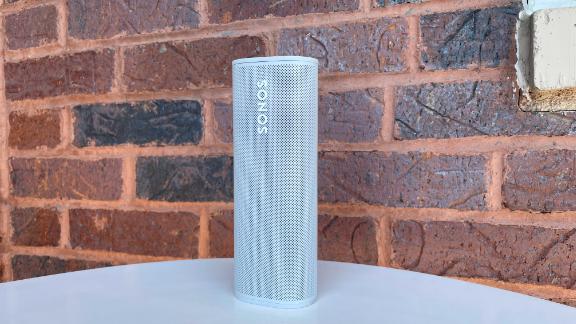
Mike Andronico/CNN
The Sonos Roam is the company’s smallest and most attractive speaker yet, packing Sonos’ signature style into a highly portable device that’s about the size of a small water bottle at about six and a half inches tall. We love the elegant, understated look of our Lunar White model (there’s also a Shadow Black option), but a few other color options would have been appreciated — especially compared to the rainbow of hues you’ll find on competitors from UE and JBL.
At just under a pound, the Roam is easy to pick up once it’s time to hit the road, and its smooth plastic exterior just feels good to hold. That’s paired with a firm rubber base at the bottom as well as four small rubber legs on the side, which makes it easy to position the Roam either vertically or horizontally depending on where you’re placing it.
The Roam is Sonos’ first speaker with physical controls, and they all held up well in our testing. The speaker’s rubberized top panel has buttons for pausing/playing, adjusting the volume and muting the built-in microphone, each of which triggers a satisfying chime every time you press them. The soft-touch buttons were easy to press while resistant enough to prevent accidental inputs, and their unique iconography allowed us to tell each button apart by feel.
Sonos’ latest speaker is well equipped for a trip to the beach or the pool, with an IP67 waterproof rating that allows it to be dunked in up to three feet of water for 30 minutes. We fully submerged our Roam in a bowl of water for a few minutes, and it kept on pumping out tunes even while going under. As you might expect, the Roam’s sound output was a bit muddied when it was covered in water, but once we dried the speaker off, it kept on rocking as if we just took it out of the box.
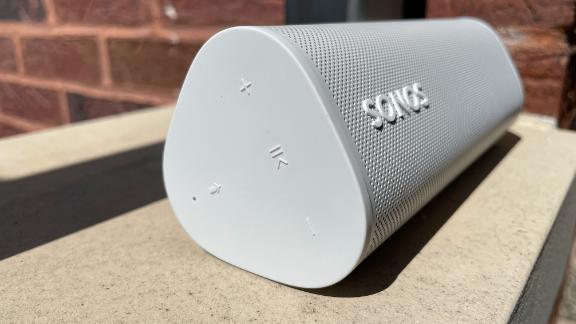
Mike Andronico/CNN
Like its big brother in the Sonos Move, the Roam is unique among portable speakers thanks to its ability to connect to both Bluetooth and Wi-Fi. The latter allows the Roam to be controlled by the Sonos S2 app on your iPhone or Android device, and integrate seamlessly with any other Sonos devices you already have in your home.
Sonos S2 is the latest version of Sonos’ software, and is required for controlling all of Sonos’ newer products (certain legacy speakers are tied to the older S1 app). It allows you to play music from various sources, as well as manage your entire system of compatible Sonos products to keep the tunes going throughout the house. Just make sure you download the right app — we accidentally downloaded Sonos S1 to start, only to find that it didn’t support the Roam.
That minor hiccup aside, setting the Roam up took only a few minutes. After downloading the app and creating an account, all we had to do was tap our phone against the speaker to sync the two up and then connect the Roam to our Wi-Fi network, and we were ready to get started.
When you’re using the Roam over Wi-Fi, the Sonos app is essentially the speaker’s command center. The app works with more than 100 music services, including heavy hitters like Spotify, Apple Music, YouTube Music and Pandora, as well more niche platforms like meditation app Calm and the Plex media library. So instead of using those individual apps on your phone, you’ll use the Sonos app to import your services of choice, log in with any user accounts you already have, and control your playback from there. Setting up services such as Spotify and Apple Music generally took just a few taps of the screen — once you select a service, you’ll be redirected to that service’s app or login page for authorization, and then you’ll be good to go.
This is how music playback is handled on all Sonos speakers, and it has its pros and cons. On one hand, you have all of your streaming platforms in one place, allowing you to search multiple services at once for a more obscure artist or switch between the likes of Spotify and Apple Music on the fly. But these services look and feel different within the Sonos app compared to their own apps, which can make things a little jarring.
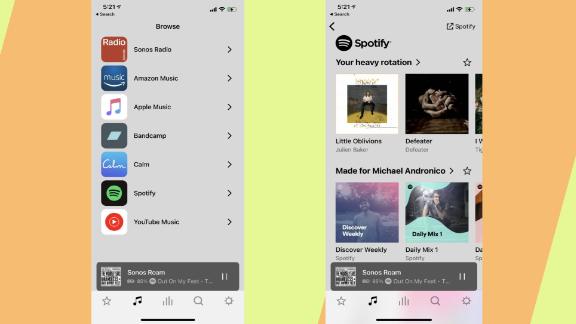
Mike Andronico/CNN
For example, while the Sonos app version of Spotify surfaced all of our recent artists and playlists, we couldn’t find an easy way to pull up podcasts. And when combing through Phoebe Bridgers’ discography on Apple Music via the Sonos app, we found that things weren’t organized chronologically, making it hard to find her latest album.
Making matters more confusing is that the Sonos app doesn’t sync up playback with any other music apps you might have on your phone, so if you’re using Spotify through Sonos and open up the regular Spotify app, you won’t see your current track. Longtime Sonos users might be used to this, but we personally felt a bit locked in by the Sonos software, and had to retrain ourselves a bit after being so used to switching between different music apps.
Fortunately, you can circumvent these problems by connecting the Roam to Bluetooth, which you’ll have to do anytime you take Sonos’ little speaker out of the house. Pairing the Roam to our phone via Bluetooth took seconds, and was as simple as holding down the power button and finding the Roam in our iPhone’s Bluetooth menu. Once we were connected, the Roam worked like any other Bluetooth device, automatically playing any content we fired up from any app.
Like with the larger, pricier Sonos Move, this added Bluetooth support gives the Roam much more versatility than a standard Wi-Fi based smart speaker, and also comes in handy if you simply don’t want to deal with the Sonos app. It’s also worth noting that the Wi-Fi range of the Roam is quite good if you prefer that route, as we were able to take the speaker out to our balcony and keep on listening without any interference.
The Roam works with both Amazon’s Alexa and the Google Assistant, giving you plenty of options for controlling the speaker with your voice (note that you’ll need to be on Wi-Fi to use these features). Alexa worked well in our testing, responding accurately when we asked Amazon’s assistant to tell us the weather, set a timer or pause our current song. Alexa also played nice with multiple music services at once, allowing me to request one artist on Spotify and another on Apple Music right after. And if you don’t want the Roam listening to you, there’s a handy microphone mute button right on the top of the speaker.
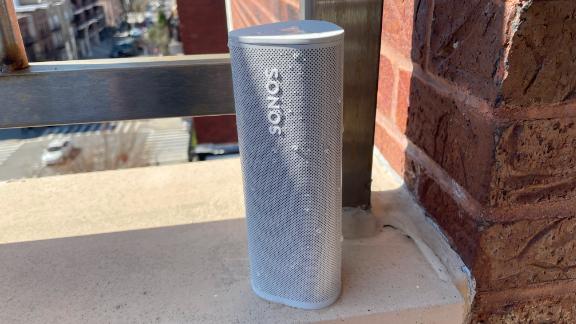
Mike Andronico/CNN
Despite its tiny frame, the Roam pumps out huge, crisp audio with more than enough volume to fill our small apartment. Seriously, this thing gets loud — we could easily hear our tunes from a room over, and after testing it out at full volume, we quickly turned things down out of fear of disturbing our neighbors.
It also simply sounds great, bringing to life every track we threw at it with a vivid soundstage that made it easy to hear every single instrument with clarity. In the bouncy pop-punk of “Can’t Wait Forever” by Tigers Jaw, the crunchy guitars, clean bass, crackling drums and searing synths all sounded equally bright and clear, providing plenty of room for the vocals to shine without overpowering them.
On the more somber indie rock tracks like Julien Baker’s “Turn Out the Lights,” the singer-songwriter’s ethereal vocals were so vivid that it sounded like she was in the room with us. That remained true even when the big electric guitars and background harmonies kicked in, creating a wall of sound that never got muddy or distorted despite its many moving parts.
The Roam also handled the atmospheric hip-hop of Kid Cudi’s “Lovin’ Me” well, giving the spacey vocals, atmospheric strings and plucky guitars all room to breathe while keeping our heads bobbing along with deep bass and snappy treble coming out of the drums.
The Roam features Sonos’ TruePlay technology, which uses the speaker’s built-in mics to automatically tune the speaker to any environment to provide the best possible sound. We tested the Roam in various settings, including our big open living room, our outdoor balcony and our small bathroom during a shower singing session, and noticed consistently clear audio quality no matter where we used it. We even tucked the speaker into our bookshelf and entertainment center — two areas where sound can easily become muffled and muted — and still noticed crisp, vibrant sound.
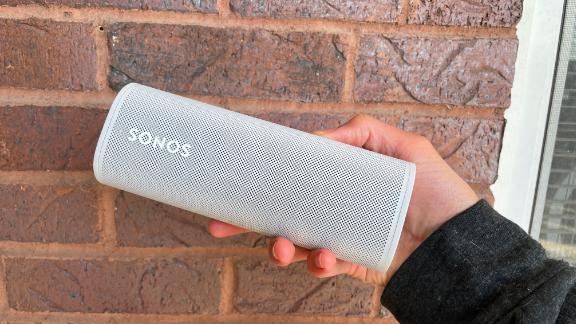
Mike Andronico/CNN
Sonos promises 10 hours of continuous music playback from the Roam, which seems in line with our testing so far. After two full days of on-and-off use, the speaker finally ran out of juice the next morning. You can likely stretch this even further if you’re only listening a few hours a day, as Sonos says the Roam can last up to 10 days on a charge in sleep mode.
You can charge the Roam using either USB-C or a Qi wireless charging mat, and we found both methods to work reliably with USB charging being a bit faster. Sonos also sells a custom Roam Wireless Charger that snaps to the bottom of the speaker magnetically and promises up to a 50% charge in two hours. However, this add-on costs a whopping $49 extra, so you’re probably better off sticking with the included cable or using a cheaper wireless charger.
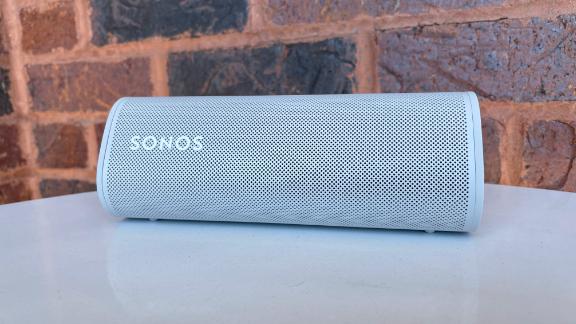
Mike Andronico/CNN
The Sonos Roam offers great sound quality and versatility for the price, pumping out rich and lively audio for all types of music while serving up a ton of features for both listening at home and on the go.
The Roam’s combination of Bluetooth and Wi-Fi support makes it a great companion for picnics and pool parties, as well as a robust smart speaker for when you want Alexa to help you with dinner while you listen to your favorite podcasts. The fact that it looks great, is super compact and can survive falling into the pool certainly doesn’t hurt either.
There’s also the Roam’s deep integration with the Sonos ecosystem, which can be both a selling point and a headache. On one hand, the fact that the Roam can work with other Sonos devices is a major plus. But using services such as Spotify and Apple Music on the Sonos app is far more cumbersome than using their respective apps, and presents a bit of a learning curve.
At the same time, if you’ve been wondering what Sonos speakers are all about, the $169 Roam is your most accessible entry point yet. Those who just want a good Bluetooth speaker they can take to the beach may want to consider simpler options such as the $129 UE Boom 3. But if you want a great-sounding portable speaker that also packs lots of smarts inside, the Roam offers a whole lot in a small package.



